| |
HBOT - Hyperbaric Oxygen Therapy in Veterinary Medicine
"HBOT is a proven and highly successful, non-invasive treatment method in which patients breathe pure oxygen inside a pressurised chamber. During treatment the blood plasma becomes saturated with oxygen which promotes a wide range of healing responses in the body.
The O2 Vet company has received media and industry coverage for successfully treating a number of high profile cases including patient recovery from long-term medical issues, accelerated healing for sports personalities, rehabilitating a wild albatross with a broken wing , accelerating healing for rare birds such as a Takahe and a little blue penguin."
http://www.nzcapstrat.com/content/02-vet
"Offering Hyperbaric Oxygen Therapy to is providing a valuable service that will often prolong or extend the animal’s life, or speed healing of many non-life threatening injuries and illnesses. HBOT can be used to treat injuries from surgery, activity, car accidents, fire (burns & lung damage), broken bones, trauma, infection, and others."
http://www.equineox.com/hbos.html
"When I started the human hyperbaric company, I was aware that this medical technology was not widely utilized. My motto is, 'Don't turn your back on change, because you could get run over.' Today, hospitals around the country are using HBOT to treat patients." He soon wondered why it shouldn't also be used for our best friends. After all, "animals suffer from many of the same disease states that we do ... some people experience claustrophobia in the hyperbaric oxygen chamber, but animals don't ... dogs and cats are nesting animals."
http://www.dogster.com
_______________________________
_______________________________ |
Japan - HBOT - Hyperbaric Oxygen Therapy - Veterinary - Dogs

Japanese Veterinarians are now providing Hyperbaric Oxygen Therapy for dogs ... and is not limited by any particular diisease, diagnosis, or breed ... while here in the United States, HBOT is still denied to brain-injured children and adults despite years of data accumulated since December 7, 1941 that demonstrates clear benefit and efficacy.
http://www.hbotruth.com
_______________________________
_______________________________ |
Canada - HBOT - Hyperbaric Oxygen Therapy - Veterinary - Thoroughbred Horses
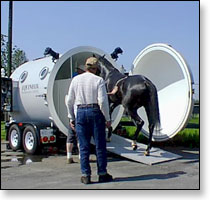
Equine athletes treated with hyperbaric oxygen therapy (HBOT) are better able to consistently compete at their full potential. Our chambers have successfully treated over two hundred horses with varying debilitating injuries. Like any medical procedure results vary, however the majority of horses showed vast improvements and accelerated healing over conventional treatment alone.
The treatments will be used on current in-training thoroughbred and standbred horses to enhance post race recovery time. By speeding the healing of injury due to the wear and tear of racing (i.e. lung and microcirculation damage), the well being of the horses with allow them to race more frequently, at higher levels.
HBOT has made possible the complete rehabilitation of horses with injuries deemed to be career ending.
HBOT’s proven ability to accelerate healing of minor wounds has consistently returned horses back to the track, saving an otherwise failed season. Reinjury rates are consistently lower than without treatment.
HBOT sessions used for general preventative athletic therapy and to treat minor chronic disease and infection allow some competition horses to race with greater frequency. Horses who could previously compete only every 2-4 weeks have been able to step to the gate weekly and compete at their full potential.
The stable with access to a hyperbaric oxygen therapy chamber has an indispensable tool to sharpen their winning edge.
Show and race animals undergo a tremendous amount of stress from racing and travel, and HBOT is proving to be very instrumental in post-race recovery in the equine world. Breeders and racers may want to consider HBOT to give their animals that competitive edge, so their animals are always at peak condition. HBOT is not only for medical treatment, but shows dramatic results in general wellness, and improved fertility.
http://www.equineox.com/hbos.html
_______________________________
_______________________________ |
Germany - O3 Ozone Therapy - Veterinary - Thoroughbred Horses
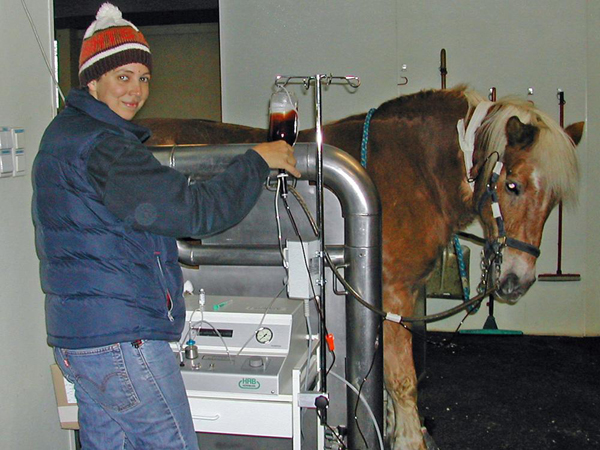
Alternative treatment methods such as ozone therapy are increasingly gaining importance in traditional medicine as supportive measures, too. HERRMANN Apparatebau GmbH has proved with its new portfolio of systems used in the treatment of four-legged patients that their pioneering concepts can be adapted for use in veterinary medicine as well.
For 25 years HAB has manufactured high-quality systems for human medicine. During their development, the latest technological and medical findings are taken into account. By now, the company from Kleinwallstadt has successfully adapted promising solutions for normobaric and hyperbaric ozone therapies for the area of veterinary medicine, thus setting new standards in its industry. Finally, four-legged patients can profit from alternative methods for the treatment of cancer or circulatory disorders like equine laminitis.
The full potential of this relatively young method has not been exploited yet. Therapists like Stephanie Kempchen contribute a lot to advancing the possibilities in daily use. In the last one and a half years the assistant doctor from the animal hospital in Wahlstedt, Germany has been able to achieve good results in the treatment of horse diseases with hyperbaric ozone therapy.
Especially in the chronic obstructive pulmonary disease COPD, equine laminitis, summer itch, and several wound healing disorders could this treatment method be implemented with a convincing outcome. In many cases Kempchen was able to attain an improvement of the physical condition after just a few treatment sessions.
In a study on equine laminitis with twelve animals, the overall health situation of all of the horses improved substantially', says Kempchen. Today about 60 per cent of the treated animals only suffer from minor ailments or are even free of complaints. Before they became candidates for participating in this study, veterinary euthanasia would have been the only alternative.
But the vast opportunities of hyerbaric therapy are not restricted to horses. The animal hospital in Wahlstedt, Germany has been very successful in treating dogs with ozone as well. Open fractures are often accompanied by wound healing disorders.
In many of these cases, hyperbaric ozone therapy has been an efficient supportive measure to alleviate suffering and accelerate the healing process. An entirely new treatment approach is implemented in ozone therapy with the ozone gas processor 'Vetozon ip'.
At a pre-clinic study at the University of Marburg, the system was used successfully for tumour treatment in rabbits. Veterinary surgeon Dr. Bernd Schurig from Ostrau, Germany, has made extremely positive experiences with Vetozon ip, too. More than 60 per cent of our patients were able to profit from a physical improvement when ozone therapy was used as a supportive treatment measure', he says. 'Basically, ozone can be used in a large number of cases since it fights bacteria, viruses, and fungi reliably.'
http://www.openpr.com
_______________________________
_______________________________ |
U.S. - South Florida - HBOT - Hyperbaric Oxygen Therapy - Veterinary - Cats
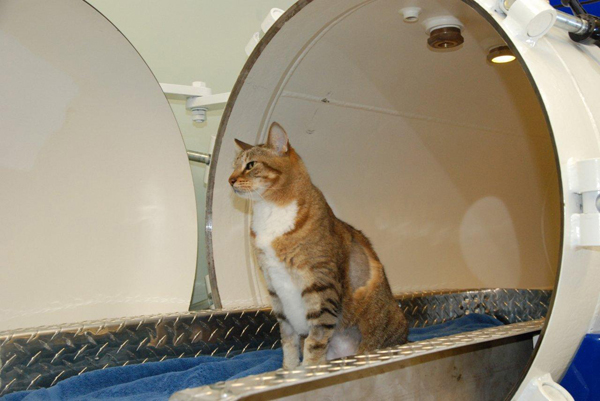
Calusa Veterinary Center in Boca Raton, Florida, was among the first animal hospital in the nation to acquire a hyperbaric chamber, which is more compact than ones for humans. "Treatment times last about one hour and are given one or two times daily," says Calusa's Dr. Andrew Turkell. "Most patients require no sedation and remain calm and relaxed during the treatment." The animals safely and painlessly inhale and absorb the oxygen.
Hyperbaric oxygen therapy is often used in combination with other forms of therapy to treat injuries and illnesses including wounds and burns, post-surgical swelling, sepsis, pancreatitis, necrosis, and stroke. It reduces swelling and inflammation, eases pressure and edema caused by head or spinal cord injuries, stimulates new blood vessel formation in healing tissues, improves control of infection, and promotes wound healing.
http://www.dogster.com
_______________________________
_______________________________ |
U.S. - Tennessee - HBOT - Hyperbaric Oxygen Therapy - Veterinary - Horses
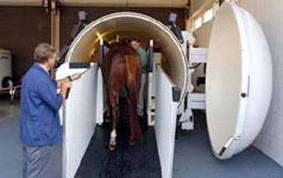
New Horse Therapy Available At University Of Tennessee Equine sports medicine has entered into a new era at the University of Tennessee College of Veterinary Medicine. The college is now one of six veterinary facilities in the nation with hyperbaric oxygen therapy capabilities.
Hyperbaric oxygen therapy (HBOT) is a therapeutic procedure designed to deliver increased concentrations of oxygen to the blood stream or directly to diseased or injured tissues. The UT Department of Large Animal Clinical Sciences has received a $200,000, two-horse HBOT chamber from Equine Oxygen Therapy Acquisitions LP.
UT will be working with the Kentucky Equine Sports Medicine and Rehabilitation Center (KESMARC) to set up protocols for clinical cases and to develop research protocols to investigate the use of HBOT in the horse.
HBOT is gaining acceptance in the medical and veterinary communities as an adjunct therapy that complements traditional treatment of a variety of acute and chronic conditions. In diseased or injured tissue, the blood supply is often compromised, and the amount of oxygen delivered is reduced, which inhibits healing. This is especially true for injuries to the limbs of large animals like horses, where the blood supply is poor even in a healthy animal.
With HBOT, the patient is placed in a chamber that delivers pure oxygen under pressure, increasing the concentration of dissolved oxygen in the blood by a factor of 15 times, depending on the pressure. By reducing tissue swelling and inflammation, HBOT enhances the repair of connective tissue and is beneficial in many training and athletic injuries.
Acute conditions that benefit from HBOT treatment include trauma, leg wounds, central nervous system damage and surgical trauma (incisions). Chronic conditions improved by HBOT treatment include large, poorly healing wounds; bone infections; internal abscesses; loss of blood supply and necrosis; foal infections and possibly laminitis.
For more information about HBOT and UT's equine sports medicine program, contact Dr. Dennis R. Geiser, Dept. of Large Animal Clinical Sciences, UT College of Veterinary Medicine, 2407 River Drive, Knoxville, Tenn. 37996-4545, phone: 865-974-5703, FAX: 865-974-5773, e-mail: Dgeiser@utk.edu
http://www.midsouthhorsereview.com
_______________________________
_______________________________ |
U.S. - South Florida - HBOT - Hyperbaric Oxygen Therapy - Veterinary - Dogs
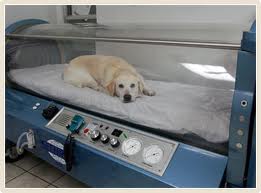
Hyperbaric Oxygen Therapy (HBOT) is a medical treatment offered in our Fort Pierce, FL veterinarian office, that aids healing by reducing swelling, controlling infection and stimulating new blood vessel formation in healing tissues.
The patient is placed in a large, clear plastic chamber that has a pressurized flow of pure oxygen about 1.5 to 3 times that of atmospheric oxygen. This allows more oxygen into the bloodstream, speeding up the healing process.
Inside the chamber, pets lie on a soft blanket and rest or sleep while the oxygen goes to work on wounds, swelling, burns and other injuries or illnesses. The pets are comfortable and relaxed during dog/cat hyperbaric therapy treatment. The total HBOT treatment time is from 1 to 2 hours, and is usually repeated twice a day.
Treatments continue until the doctors see a marked improvement. When your pet is beginning to use the affected limb, or is gaining strength and function, the animal hyperbaric oxygen chamber treatments are discontinued.
Our Fort Pierce, FL veterinarian-administered HBOT treatment can be used successfully to treat:
- Post operative swelling
- Snake bites
- Serious wounds and burns
- Head or spinal trauma
- Near-drowning or asphyxiation
- Smoke inhalation
Over the past few years it has been very rewarding for the doctors and staff to observe the clinical improvement of the many cases treated by cat/dog hyperbaric oxygen therapy at our Fort Pierce, FL veterinarian hospital. The addition of this HBOT therapy has resulted in an obvious enhancement of our ability to successfully treat many critically-ill patients.
http://animalemergency.net/hbot.php
_______________________________
_______________________________ |
U.S. - Nevada - O3 Ozone Therapy - Veterinary - Dogs
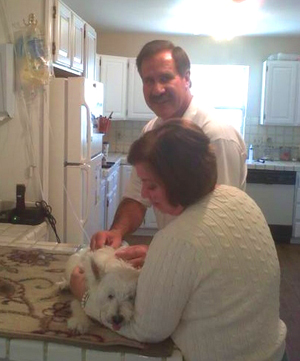
Lack of Oxygen and Disease
Aging and degenerative diseases are caused by decreased oxygen utilization by the tissues. The unit within each cell that causes effective utilization is called the mitochondria, and it is powered by NAD/NADH ratio.
Decreased oxygen utilization can be due to pre-mitochondrial factors (decreased lipolysis, inflammation, hypoglycemia, hypoxia, ischemia) or mitochondrial factors (toxicity, infections, stress, nutritional and hormonal deficiencies, decreased fitness) which causes increased free radical production and the subsequent degenerative diseases associated with aging.
What does Ozone Therapy do?
Ozone therapy stimulates oxygen utilization by improving the NAD/NADH ratio and by decreasing the rate of decay of mitochondria present in the tissues.
Ozone reacts with lipids in the cell membrane to form ozonides which convert NADH to NAD, thus increasing oxygen utilization.
Ozonides are also antibacterial, antifungal and antiviral, and enhance chemotherapy and radiation. Cancer thrives in areas of poor oxygenation and cancers actively inhibit cellular reactions in mitochondria, creating areas of hypoxia and poor oxygen utilization.
Ozonides increase the function of the mitochondria increasing oxygenation of tissues, thereby inhibiting the spread of cancer.
Ozone therapy increases the buffering of free radicals much better than oral antioxidant therapy does. Ozone also stimulates cytokines (tumor necrosis factor, interleukin 2, interferon G) that fight cancer, because they stimulate the immune system without causing side effects. Direct injection into cancer causes tumor cell to rupture (apoptosis). They also protect healthy cell against the side effects of chemotherapy or radiation therapy by increasing antioxidant enzyme activity.
How can we use Ozone Therapy in veterinary medicine?
1. Can be used I wound management, hot spots, abscesses, allergic dermatitis, etc.
2. Chronic and acute lymes disease
3. Acute and chronic liver disease
4. Acute and chronic kidney disease
5. Pancreatitis
6. Viral and bacterial diarrhea
7. Adjunctive cancer therapy
8. Stomatitis, gingivitis
9. Chronic ear infections, yeasty ear infections
10. Seizures
11. Autoimmune reactions
12. Ear hematomas
http://www.holisticpetdr.com/ozone.php
_______________________________
_______________________________ |
U.S. - California - HBOT - Hyperbaric Oxygen Therapy - Veterinary - Horses
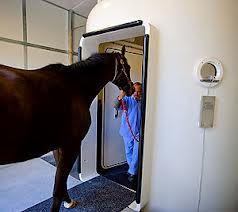
In 2000, the Alamo Pintado Equine Medical Center acquired the first hyperbaric oxygen chamber designed specifically for horses, and became the first veterinary hospital in the United States to offer hyperbaric oxygen therapy to equine patients.
In the past decade, the Center has incorporated new technological advances and the hyperbaric chamber now is able to immerse the patient in a pure oxygen environment at 2 to 3 atmospheres of pressure for the duration of the treatment. This promotes an increase in tissue oxygenation by as much as 15 times over normal levels.
Some of the beneficial effects of hyperbaric oxygen therapy include increased antibacterial activities of oxygen on specific anaerobic bacteria, enhanced white blood cell activity, reduction of tissue edema, maintenance of tissue oxygenation in instances of decreased hemoglobin content in the blood, and stimulation of fibroblast activity and collagen deposition. Collectively, these effects facilitate wound healing and stimulate the growth of capillary beds into injured tissues.
http://www.alamopintado.com
_______________________________
_______________________________ |
Canada - HBOT - Hyperbaric Oxygen Therapy - Veterinary - Dogs
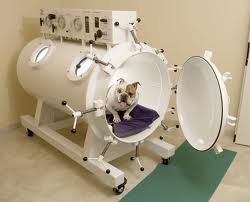
Hyperbaric Oxygen Therapy (HBOT), a new state-of-the-art adjunctive therapy is now available for veterinary animal patients at VCA SouthPaws Veterinary Specialists & Emergency Center. HBOT is an exciting and rare new therapy that is available for small animals at only five registered locations in the entire U.S., including the new installation at SouthPaws.
Our HBOT team is led by Dr. Jeff Norton of our Surgery Department. Dr. Norton is a respected veterinary surgeon, researcher and speaker – and has extensive training in HBOT:
“I’ve used HBOT in hundreds of soft tissue, orthopedic and neurosurgical patients over the last four years before I joined VCA SouthPaws team, and am very excited about being able to add this therapeutic modality which will improve outcomes in patients with osteomyelitis, crush/degloving injuries, skin graphs and flaps, and IVDD. We’re expecting to see faster recovery times in patients who have delayed post-radiation therapy healing and in those with acute pancreatitis as well. If you think you have a patient who might benefit from HBOT, please call me.”
HBOT effectively treats each of these conditions:
- Acute ischemias, including compartment syndrome and crush injuries
- Poorly healing wounds
- Burns
- Necrotizing soft tissue infections
- Intracranial abscesses
- Delayed radiation injuries
- Clostridial myositis/myonecrosis
- Refractory osteomyelitis
- Others (carbon Monoxide poisoning, air/gas embolism)
Possible additional indications include:
- Spinal cord injuries and nerve injuries
- Peripheral neuropathies
- Ileus &post-operative GI surgeries with compromised vasculature
- Pancreatitis & Hepatitis
- Fungal diseases
- Cranial traumas
- Cellulitis & diabetes complications
Have questions? Or want to refer a patient? Call (703) 752-9100 today and ask for Dr. Jeff Norton or the surgery patient care coordinator. We would be happy to provide you with more information or to set up a HBOT demonstration for you. If you wish to refer a patient to us immediately or at any time, please contact us and we will be happy to assist with your case. We look forward to working with you.
http://www.vcahospitals.com
_______________________________
_______________________________ |
U.S. - South Florida - HBOT - Hyperbaric Oxygen Therapy - Veterinary - Dogs
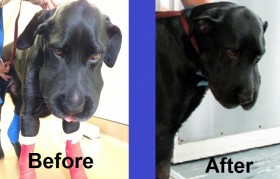
Thanks to the advanced HBOT treatment at SPCA Florida’s McClurg Animal Medical Center, Mastriano was able to report significant progress after the first hour-long session. Dante arrived with his head down, tail between his legs and snout swollen to almost 17 inches.
He emerged from the oxygen treatment wagging his tail, happily greeting medical center staff, and his snout reduced to 12 inches. Mastriano was relieved to share the good news with her daughter, Charlotte “Charlie” Eierle, 4,500 miles away.
http://www.spcaflorida.org
_______________________________
_______________________________ |
Oxygen Medicine Treatments and Applications in Veterinary Medicine
Administering O3 Ozone
Autohemotherapy
| O3 |
 |
O3 Ozone Oxygen Medicine - Blood Lactate Variation After Treatment in Thoroughbred Racehorses |
 |
|
- Decrease in blood lactate concentration after maximal effort
- Increased pyruvate oxidation, thus increasing Acetil-Coa production
- Activation of cellular enzymal protection system
- Activation of the erythrocyte metabolis
- Increased 2,3-diphosphogliceric acid cycle
- Increased redox function of the mitochondrial respiratory chain.
|
Cancer
| O3 |
 |
O3 Ozone Oxygen Medicine - Case Studies on Cancer in Horses |
 |
|
Case Studies of healing wound infections and destroyed thigh tumor.
|
Equine Laminitis
| O3 |
 |
Equine Laminitis - Hyperbaric Oxygen Substantially Improved Equine Laminitis and Reduced the need for Euthanasia |
| HBOT |
|
'In a study on equine laminitis with twelve animals, the overall health situation of all of the horses improved substantially', says Kempchen.
Today about 60 per cent of the treated animals only suffer from minor ailments or are even free of complaints. Before they became candidates for participating in this study, veterinary euthanasia would have been the only alternative.
But the vast opportunities of hyerbaric therapy are not restricted to horses. The animal hospital in Wahlstedt has been very successful in treating dogs with ozone as well. Open fractures are often accompanied by wound healing disorders. In many of these cases, hyperbaric ozone therapy has been an efficient supportive measure to alleviate suffering and accelerate the healing process.
|
 |
|
|
Hepatitis
| O3 |
 |
Misteltoe - Effect of Viscum Album on Acute Hepatic Liver Damage Caused by Carbon Tetrachloride in Rats |
 |
|
Results suggest mistletoe preparations may be useful therapeutic intervention for patients with chronic liver disease. Mistletoe preparations are widely used unconventional cancer therapies in many advanced medical countries throughout the world (but not USA). Patients with chronic hepatitis C reported a significant improvement in elevated transaminases with mistletoe preparations.
|
HIV - Hepatitis - Herpes Virus
| O3 |
 |
HIV, Hepatitis, Herpes Virus - 100% Safe Viral Inactivation - wth O3 Ozone Oxygen Medicine Treatments |
| ***** |
|
NATO endorses joint U.S. / Canadian O3 Ozone oxygen research. 100% safe inactivation of HIV, Hepatitis, Herpes Virus in blood.
In a brief to the NATO Blood Committee' the Surgeon General of the Canadian Armed Forces reported on joint U.S. Canadian findings that within the sensitivity of the screening methods used, a 3-minute ozonation of serum spiked with one million HIV-1 particles per millilitre would achieve virtually 100% viral inactivation (loss of infectivity):
* N.A.T.O.: The NATO Blood Committee endorses joint U.S. / Canadian findings regarding O3 Ozone research.
* United States and Canada: 3-minute ozonation of serum spiked with one million HIV-1 particles per millilitre would achieve virtually 100% viral inactivation (loss of infectivity).
* Germany: 10 000+ units of human blood containing hepatitis virus were rendered safe through treatment with a mixture of ozone (O3) and oxygen (O2) for transfusion.
* Canada: Clinical trial of O3 Ozone in the treatment of AIDS patients (by means of phlebotomy, O3 ozonation of the blood sample and intramuscular reinoculation) ... showed no evidence of serious side effects.
* United States: Two teams of US virologists have used comparable gas-diffusion techniques to confirm the Canadian findings.
* United State and Europe: Findings at laboratories in North America and Europe have demonstrated that ozone has remarkable potency against disease factors in blood products.
* United States and Canada: Ozonized biologic fluids, in which there is a presumed abundance of superoxide, singlet oxygen, hydroxyl and peroxyl radicals and other highly reactive species, had both extracellular and intracellular virucidal properties.
Ref: http://mosao2.org/Article%20-%20O3/O3_HIV_NATO_Canada.html
Ref: http://www.ncbi.nlm.nih.gov/pmc/articles/PMC1490857/
|
| |
|
|
 |
|
|
| |
|
|
HIV - Hepatitis - Herpes Virus
| O3 |
 |
1. HIV- Inactivation of (HIV) Human Immunodeficiency Virus Type 1 by O3 Ozone in vitro |
| ***** |
|
Ozone was found to inactivate HIV-1 virions in a dose-dependent manner. Greater than 11 log inactivation was achieved within 2 hours at a concentration of 1,200 ppm ozone. The data indicate that the antiviral effects of ozone include viral particle disruption, reverse transcriptase inactivation, and/or a perturbation of the ability of the virus to bind to its receptor on target cells.
Ozone has potent anti-HIV-1 activity in cell culture media and factor VI11 preparations ... it is readily apparent that ozone may be of use in rendering factor VI11 and possibly other blood products, both proteinaceous and cellular, free of HIV-1 and other infectious agents. Ozone treatment offers promise as a means to inactivate human retroviruses in human body fluids and blood product preparations.
|
| |
|
|
 |
|
|
| |
|
|
Herpes Virus - Herpatic Keratitis
| O3 |
 |
Herpatic Ketatitis - O3 Ozone - APPLICATION OF OZONE THERAPY IN VETERINARY OPHTHALMOLOGY |
| ***** |
|
1DVM Clínica Veterinaria Dr. Vigna. Vía Primo Maggio, 34 40026, Imola, Italy.
2 Ozone Research Center. POBox 6414, Havana, Cuba.
ivanvigna@tin.it
silvia.gra@infomed.sld.cu
ABSTRACT:
The satisfactory use of ozone therapy in the field of Ophthalmology has been already reported. For the therapy of the eye anterior chamber (above all the herpetic keratitis), in humans and Veterinary, the application of ozone injection, by subconjunctival way, the use of ozonized sunflower oil (OLEOZON) collyrium, in conjunction with ozone rectal insufflation, are well known.
Taking into account the OLEOZON great germicide power, the capacity to favor the cicatrization and the anti-inflammatory effect, the aim of this paper is to evaluate its efficacy applying, as unique medication, in cats affected by herpetic keratitis and chlamydiosis, associated to the midriatic in order to avoid the iris anterior synechia, as well as in corneal ulcer and in corneal ulcer treated with conjunctival flaps.
This study was performed in cats of different origin and age. Local treatment over the lesions was applied using OLEOZON collyrium, every 8 hours. Evaluation was performed every 72 h and every 4 h after the conjunctival flaps. The healing criteria were the inflammation disappearance and ulcer cicatrization.
In comparison with known pharmacological conventional therapies, the OLEOZON collyrium treatment was superior, more simple and more rapidly to achieve the results.
Only one contraindication of this medication was observed in 1 cat with herpetic symblepharon, due to the capacity of OLEOZON to increase fibroblasts. It is interesting to consider the good corneal cicatrization obtained with this treatment. No side effects were observed during the study |
| |
|
|
 |
|
|
| |
|
|
Laminitis Equine Laminitis
| O3 |
 |
Equine Laminitis - Hyperbaric Oxygen Substantially Improved Equine Laminitis and Reduced the need for Euthanasia |
 |
|
'In a study on equine laminitis with twelve animals, the overall health situation of all of the horses improved substantially', says Kempchen.
Today about 60 per cent of the treated animals only suffer from minor ailments or are even free of complaints. Before they became candidates for participating in this study, veterinary euthanasia would have been the only alternative.
But the vast opportunities of hyerbaric therapy are not restricted to horses. The animal hospital in Wahlstedt has been very successful in treating dogs with ozone as well. Open fractures are often accompanied by wound healing disorders. In many of these cases, hyperbaric ozone therapy has been an efficient supportive measure to alleviate suffering and accelerate the healing process.
|
Lyme Disease
| O3 |
 |
O3 Ozone Oxygen Medicine - Treating Foot Rot in Dairy Cows vs Ceftiofur vs Oxytetracycline |
 |
|
Ceftiofur = cured Foot Rot in 3 days (subject to withdrawal time).
Oxytetracycline = cured Foot Rot in 3 days (subject to withdrawal time).
O3 Ozone Oxygen autohemotherapy treatment = cured in 1 day, best results - (NOT subject to withdrawal time).
|
Reproduction
| O3 |
 |
O3 Ozone Oxygen Medicine - Reproductiion Efficiency in Holstein Cows |
 |
|
Preventive O3 Ozone intrauterine application during early puerperal period, especially the foaming form of O3 Ozone preparations (spray), improved the reproductive efficacy in dairy cows.
|
Viruses - HIV / Hepatitis
| O3 |
 |
1. HIV- Inactivation of (HIV) Human Immunodeficiency Virus Type 1 by O3 Ozone in vitro |
| ***** |
|
Ozone was found to inactivate HIV-1 virions in a dose-dependent manner. Greater than 11 log inactivation was achieved within 2 hours at a concentration of 1,200 ppm ozone. The data indicate that the antiviral effects of ozone include viral particle disruption, reverse transcriptase inactivation, and/or a perturbation of the ability of the virus to bind to its receptor on target cells.
Ozone has potent anti-HIV-1 activity in cell culture media and factor VI11 preparations ... it is readily apparent that ozone may be of use in rendering factor VI11 and possibly other blood products, both proteinaceous and cellular, free of HIV-1 and other infectious agents. Ozone treatment offers promise as a means to inactivate human retroviruses in human body fluids and blood product preparations.
|
| |
|
|
 |
|
|
| |
|
|
Viruses - West Nile Virus
| O3 |
 |
ACHH Mushroom - Wsert Nile Virus - Oral Administration of Active Hexose Correlated Compound Enhances Resistance |
| ***** |
|
Abstract
West Nile virus (WNV) poses a serious threat to public health, especially to the elderly and the immuno-compromised. Neither vaccines nor treatments are available for humans. Active hexose correlated compound (AHCC) is an extract ofLentinula edodes of the Basidiomycete family of fungi rich in α-glucans. In this study, we evaluated the effect of AHCC on host susceptibility in the murine model of WNV infection.
Mice orally administered with AHCC (600 mg/kg) every other day for 1 wk before and at d 1 and 3 postinfection were assessed using viremia levels, survival rate, and protective immunity. AHCC administration in young (6- to 8-wk-old) mice attenuated viremia and mortality following lethal WNV infection. WNV-specific IgM and IgG production and γδ T cell expansion were also enhanced in these mice. Aged (21- to 22-mo-old) mice were more susceptible to WNV infection than young mice, partially due to the dysfunction ofγδ T cell subsets.
AHCC administration in aged mice enhanced the protective Vγ1+ T cell response as well as WNV-specific IgG but not IgM antibodies production.
AHCC administration in aged mice attenuated viremia levels but led to no difference in mortality rate.
Overall, our data suggests that AHCC enhances protective host immune responses against WNV infection in young and aged mice. Dietary supplementation with AHCC may be potentially immunotherapeutic for WNV-susceptible populations.
http://jn.nutrition.org/content/early/2009/01/13/jn.108.100297
http://www.ahccresearch.com/testimonials.html
|
| |
|
|
 |
|
|
| |
|
|
________________________________________
|
Abstracts
| O3 |
 |
Abstracts - International O3 Congresses |
 |
|
Cats:
OZ-PO-037: NEURO-PHYSIOLOGICAL AND BIOCHEMICAL EFFECTS OF OZONIZED SOLUTIONS APPLICATION IN EXPERIMENTS WITH CATS.
S.Kotov; A.Edeleva and A.Mochalov.
Nizhni Novgorod Medical State Academy. Russia.
In the mechanism of the biological action of ozone there are many obscure questions concerning its immediate influence on the nervous tissue. The aim of this research is to study, in experimental conditions, the influence of an ozonized solution containing middle therapeutic concentration of ozone in the somatosensory caused potential (SP), in the enzyme activity of the aerobic metabolism and in the contents of peroxidation lipid products in a somatosensory zone of the cortex in cats brain.
The registration of the caused potential was made on an open brain of 13 adult cats which received intraperitoneal nembutalo-chlorosoli narcosis. With this purpose an electrical boring rendered branches of the radial nerve in the area of the wished joint. Consecutive application of nonozonized and ozonized solution was carried out. In subsequent, the site of the brain was exposed to biochemical researches.
The ozonized solution causes a peak latence decrease of a negative phase in caused potentials to 85 %, from an initial level, in combination with a convertible short-term (10 min) augmentation of the positive phase amplitude in caused potential (26 %). Simultaneously, insignificant raises of the initial peroxidation lipid products were obtained in the researched site of the brain.
The enzymes activity of the respiratory chain does not change simultaneously with the appreciable intensifying of oxidoreductases, activity such as: lactat- dehydrogenases, piruvatdehydrogenases, succinatedehydrogenases.
The ozonized solution stimulates the aerobic glycolysis, raises functional neurones activity of the top cortical layers, not rendering any toxic effect on the excitability and conduction of the nervous tissue
________________________________________ |
Dogs:
OZ-P-073: O3 OZONE TREATMENT OF APPLICATION In The malignant NEOPLASMS IN DOGS.
T.Scherbatyuk, G.Poslov and V.Illarionov.
Medical Academy, Nizhny Novgorod, Russia.
Dogs with malignant neoplasms Were Used In This Study.
Ozone therapy by intravenous infusion WAS Applied Physiological saline solution of ozonized (100 - 200 mL, ozone concentration in the gas mixture 800 mcg / L) and by local application: intratumoral and peritumoral injection of Physiological saline solution ozonized. A cycle of Treatment Lasted from 5 to 15 days.
The results Indicated That, ozone therapy on malignant Animals with tumors, tumor metabolism Affected STI and stopped action on pathologic organism, Confirmed by the normalization of blood biochemical indices in tumor Treated animals.
Free-radical attack Caused by local action of ozone led to the Intensification of tumor cell respiration, on one hand, and to the suppression of the antioxidant defense system neoplasia, on the other hand.
Cell death of uncertain part of tumor popullation finally occured, Which led to the DECREASE in the sizes and the necrotic blastoma Processes development. Surgical procedure, In This case, in order to necesario is clean the damage of the necrotic tissue Tumour mass.
________________________________________ |
Pigs:
O3 Ozone Therapy: a New Option in Veterinary Medicine.
Camps A.M. and Elías-Calles B.
The effect of ozonized sunflower oil (OLEOZON®) on tissue wounds performed by castration of Yorkshire race pigs was studied. The experiment was done after performing a wound in the scrotal region of fifteen pigs with 90 days old and sixty three pounds weight. They were divided into three groups (A, B and C) of five animals each. Group A - animals treated with placebo, once a day, topically, during five days. Group B - animals treated with OLEOZON®, once a day, topically, during five days. Group C - animals treated with OLEOZON®, twice a day, topically, during five days.
The results showed an important positive effect of OLEOZON® on wound healings, achieving the best results in group C in which the wound scarred more rapidly than in groups B and A, with significant differences (p < 0.05). Our data indicate that the topic application of OLEOZON® has a cicatrization and regenerating effects on dermic wounds in pigs.
________________________________________ |
Rodents:
OZ-P-062: A STUDY OF THE EFFECT OF O3 OZONE MUTAGENIC rectal insufflation ADMINISTERED BY IN RODENTS.
National Center for Laboratory Animal Production,
Ozone Research Center.
The reaction of ozone with lipids occurs exclusively at the level of carbon-carbon double bonds present in the polyunsaturated fatty acids, organic peroxides and generating ozonides, which in adequate amounts and controlled exert different biological actions, which give a set ozone therapeutic properties.
In this work we studied the possible mutagenic effects of ozone applied rectally. We used analysis of bone marrow in NMRI mice by the micronucleus test and SPRD rats using the chromosome aberration test. Two concentrations were used ozone (50 and 75 mg / mL). As negative and positive controls were used oxygen and cyclophosphamide (40 mg / kg) respectively. 10 administrations were performed every 24 hours. At the end of treatment animals were sacrificed and processed for bone marrow preparations.
The results show no evidence of cytotoxic or clastogenic (induction of chromosome aberrations) in the bone marrow of rodents treated.
________________________________________ |
Protective Effects of O3 Ozone Oxidative Preconditioning Against Liver Ischemia/Reperfusion Injury in Rats.
León O.S. and Ajamiech H.
Liver transplantation is a recommended therapy for end-stage liver disease and the demand for donor organs has surpassed the supply resulting in the death of thousands of patients. The damage by hepatic ischemia/reperfusion (I/R) is considered as the main responsible of organic failure after transplantation. On the other hand, 30% of transplants still fail by acute or chronic rejection within five years.
The mechanisms of acute liver damage following I/R are thought to involve a complex interaction of immediate cellular damage caused by different mediators.
In the process of prolonged ischemia, a major caused of primary liver dysfunction in donor grafts results from the generation of reactive oxygen species (ROS) which are associated to pathogenesis of inflammatory disorders including I/R injury.
From the mechanism of Ozone Oxidative Preconditioning (OzoneOP) invoked by our research group, it is shown the protective effects of ozone on important enzymes as Xanthine Deshidrogenase-Xanthine Oxidase and Superoxide Dismutase: CuZn/SOD and Mn/SOD, among others).
It is demonstrated that Ozone OP regulate the Nitric Oxide levels and other mediators which take part in the cellular redox balance.
Ozone OP participation in the novo protein synthesis as protector mechanism for morphological integrity of the liver in the preconditionated groups is shown.
The protection conferred by ozone treatment indicates that this therapeutic alternative may be successful against hepatic damage mediated by I/R associated to liver transplantation.
________________________________________ |
OZ-P-130: EVALUATION OF O3 OLEOZON ® TOXICITY TEST IN CLASS.
National Center for Laboratory Animal Production, Center for Toxicology and Animal Experimentation,
Ozone Research Center.
The toxicity test class is an alternative assay in vivo for classifying the substance as its range of toxicity. In this case allowed to classify the OLEOZON ® . For which 12 rats were used in the subline Cenp: SPRD randomly distributed at the rate of six animals per experimental group, three of each sex.
The animals were housed in plastic boxes of polycarbonate (Makrolon) type Tecniplast T 4 , maintained under conditions suitable for the species, with a temperature of 20 ± 4 ° C, relative humidity 70 ± 10% and photoperiod 12 h light-12 h darkness. The dosing was performed in a single dose via oral gavage at a rate of 2 000 mg / kg body weight of animals prior fasting for 12 h.
The control group was administered the vehicle (sunflower oil) and treated (OLEOZON ® ). Were recorded daily clinical signs and body weight of individual animals prior to administration, and at 7 and 14 days of the trial.
This substance caused no deaths or clinical signs, there was no difference in body weight, showed no gross lesions in cavities or organs at this dose. In sane with the Classification System of Acute Toxicity, according to the classification system, the substance is not classified, the DL50 is> 2 000 mg / kg body weight.
________________________________________ |
OZ-P-064: DNA DAMAGE IN PERIPHERAL BLOOD LEUKOCYTES AND exfoliated cell COLORECTAL MUCOSA OF RATS TREATED WITH O3 OZONE.
Centre for Biologics Evaluation and Research, Institute of Food and Drugs,
Biomedical Research Centre.
Treatment with ozone (O3) has gained prominence because of its efficacy in various diseases associated with deficits in antioxidant defenses. However, this has proven toxic gas inhalation and have been reported studies have demonstrated its mutagenic and genotoxic in microorganisms in animals and human cells in vitro. Colorectal insufflation of the pathways is the most widely used in therapy application and whereby the mucosal cells are directly exposed to the agent.
To study the effect of treatment on colorectal cells as well as the effect on peripheral blood leukocytes was used the rat as an experimental model, which has been used successfully in other trials with O3. Rats were treated for 4 d with 42 mg / mL for body weight. It also used an untreated control (NT) and a positive control with bleomycin (BLM).
Samples were taken after different treatments with the gas. DNA damage occurred both in exfoliated cells and in leukocytes and showed a gradual increase of the length of migration and the percentage of damaged cells as a function of sampling time.
The samples after 48 h of treatment indicate a trend toward recovery of the damage or removal of damaged cells nonviable.
Through this study it is found that O3 damage generated both in cells directly exposed, as in leukocytes. In the latter case is probably due to the action of its reactive intermediates.
________________________________________ |
OZ-P-067: RECTAL ADMINISTRATION OF O3 OZONE ON INTRAPERITONEAL aseptic inflammation.
Mary O. Fox (a), Sarai River (a), Silvia Menendez (b), Ernesto Barber (a), Zullyt Zamora (b), Siegfried Schulz (c) and Maritza Victorio (a).
(a) Institute of Basic Medical Sciences Preclinical,
(b) Ozone Research Center,
(c) University of Marburg, Germany.
Was used aseptic intraperitoneal inflammation model in order to study the effects of ozone therapy could have on the phagocytic activity. Were taken 36 female Wistar rats of 250 ± 18 g body weight and divided into two study groups: experimental (E), 18 rats treated with ozone for 5 gives rectal a daily dose of 24 mg / kg body weight and control (C), 18 rats treated with oxygen for 5 d rectal.
At the end of treatment, all rats were implanted them under aseptic conditions, intraperitoneally, two sheets coverslips and then closed cavity. These slides were taken at 24 h (subgroups C1 and E1), at 3 (subgroup C3 and E3) and 4 d (subgroups C4 and E4), each subgroup containing 6 animals. Two hours before removal of the plates were inoculated with 0.5 mL of washed RBCs in saline rooster, which enable the evaluation of the phagocytic activity of mononuclear cell inflammation present in the sheets. The rats were anesthetized with a mixture xilaxin / ketamine, prior to extraction of the sheets. The cells attached to these sheets were fixed and set with reagent-May Grümwald Giensa and mounted on the corresponding slide.
Readings were taken with a light microscope in successive fields to reach 100 mononuclear cells. It also measured tumor necrosis factor (TNF) in subgroups E1, E3, E4 and a control group where only the anesthetic was applied, since it is known that drugs can have some influence on the TNF.
Yielded a significant increase (p <0.005) in phagocytic index in the subgroups E1, E3 and E4 with respect to the subgroups C1, C3 and C4, as well as the number of cells that had phagocytosed. With regard to TNF was not observed increase thereof in either group pretreated with ozone or the group with anesthetic alone.
________________________________________ |
OZ-P-068: OPTIMIZING TREATMENT OF O3 OZONE IN THE RENAL ischemia-reperfusion.
Ozone Research Center,
Institute of Preclinical Basic Sciences,
Center for Biologics Evaluation and Research Institute of Pharmacy and Food.
There are no known methods to predict which organ will work better after having had warm and cold ischemia followed by reperfusion. It was our purpose in this paper to assess the effect of ozone on rat kidneys subjected to warm ischemia, and compare the function of kidneys previously treated with ozone compared to other groups. Another objective was constituted to assess the effect of ozone on direct and indirect indicators of oxidative stress and determine the optimal period of treatment with ozone.
Our work took 80 Wistar rats of 250 g, female, grouped into 8 sets of 10 animals each which caused him renal ischemia for 30 min, followed by 3 h of reperfusion and flow midiéndosele renal plasma and the intensity of glomerular filtration and functional variables and biochemical variables by spectrophotometric techniques deterninó superoxide dismutase (SOD), phospholipase A2 and fructosamine.
Morphological studies were also conducted to determine the structural changes that appeared during the experiment. The working groups were distributed as follows: healthy control group (I), ischemic control group (II), oxygen control group at 5 d (III), oxygen control group at 10 d (IV), control group oxygen at 15 d (V), ozone group at 5 d (VI), ozone group at 10 d (VII), ozone group at 15 d (VIII).
The results showed a marked decrease in renal plasma flow and glomerular filtration rate in all groups (control ischemic, control oxygen of 5, 10 and 15 d of treatment, except for the group previously treated with ozone which values remained statistically similar to healthy controls.
Biochemical variables yielded equivalent results.
Structural lesions were significantly lower in the group treated with ozone at 15 d specifically in relation to ischemic controls and oxygen. interpreting the results is dependent on action to improve the rheological properties of the movement known ozone and the effect of "preconditioning" of the same protecting the body from oxidative stress.
________________________________________ |
OZ-P-069: Evolution of multiple organ injury, in an experimental model BURNED MOUSE, TREATED WITH ALOE B, O3 OZONE AND EPIDERMAL GROWTH FACTOR.
Surgical Hospital
Ozone Research Center.
Burn disease is a familiar theme of medical interest because it allows lines of research related to the sepsis syndrome, generalized systemic inflammation syndrome, multiple organ failure, shock and trauma among others.
The aim of this study was to evaluate the evolution of multiple organ injury in a mouse experimental model of critical burn the use of Aloe B, ozone (O3) and epidermal growth factor (EGF).
We used a dry burn model, 96 female Balb / c, divided into 4 groups: saline as control (SF), Aloe, O3 and EGF, 20 ± 2 g, 12 weeks, combined with hair removal, anesthetized with ip ketamine (150 mg / kg), 5 min before the burn. The burn was produced with an automatic welding machine with 2 bronze plaques adapted, with an area of 6 cm 2 each in the lower thoracic paravertebral region of the animal, at a temperature of 100 ° C.
The animals were resuscitated with 1 mL of SF and treated ip immediately after burn, with 15 treatments of Aloe B injection (0.3 mg/20 g in the first week and 0.2 mg/20 g in the second week , brought up to 1 mL). Were used 0.9 mL of ozone at a concentration of 37 mg / L, for 15 treatments, rectally. EGF (500 mg in 1 mL) ip, single dose.
The SF group, 1 mL ip. In groups SF, Aloe, O 3 and EGF died 12, 13, 9 and 4 animals, respectively. Regarding vitality, in the SF group 16 animals were dying and 3 with low vitality.
In the Aloe, 5 and 14 less active dying, but with vital signs. In the EGF group and O3 were 20 and 15 active animals dying and 4 and 7, respectively.
In the histological study, EGF and O3 groups showed increased activity of lymphoid tissue in the spleen and minor liver and kidney damage, while the control group showed higher expression of multiple organ failure.
________________________________________ |
|
|
|